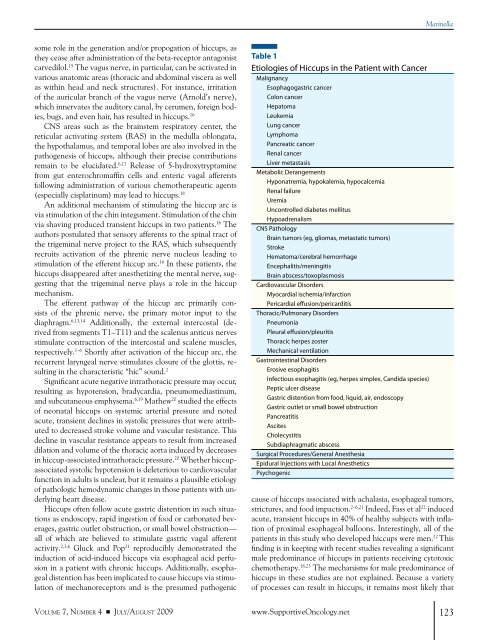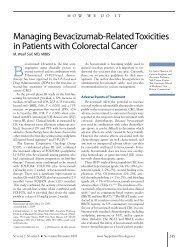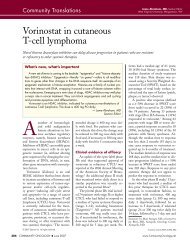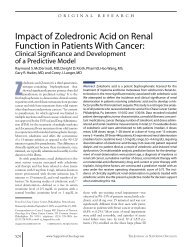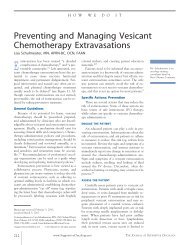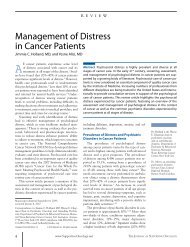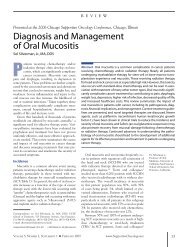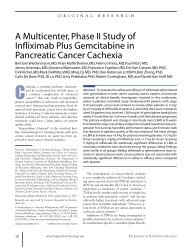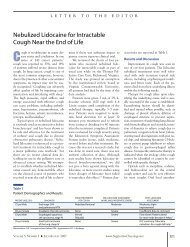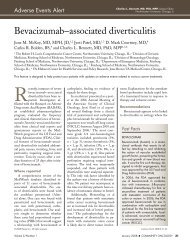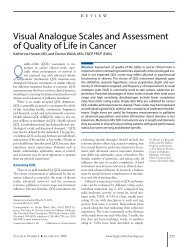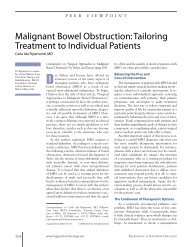Diagnosis and Management of Hiccups in the Patient - Oncology ...
Diagnosis and Management of Hiccups in the Patient - Oncology ...
Diagnosis and Management of Hiccups in the Patient - Oncology ...
You also want an ePaper? Increase the reach of your titles
YUMPU automatically turns print PDFs into web optimized ePapers that Google loves.
some role <strong>in</strong> <strong>the</strong> generation <strong>and</strong>/or propogation <strong>of</strong> hiccups, as<br />
<strong>the</strong>y cease after adm<strong>in</strong>istration <strong>of</strong> <strong>the</strong> beta-receptor antagonist<br />
carvedilol. 15 The vagus nerve, <strong>in</strong> particular, can be activated <strong>in</strong><br />
various anatomic areas (thoracic <strong>and</strong> abdom<strong>in</strong>al viscera as well<br />
as with<strong>in</strong> head <strong>and</strong> neck structures). For <strong>in</strong>stance, irritation<br />
<strong>of</strong> <strong>the</strong> auricular branch <strong>of</strong> <strong>the</strong> vagus nerve (Arnold’s nerve),<br />
which <strong>in</strong>nervates <strong>the</strong> auditory canal, by cerumen, foreign bodies,<br />
bugs, <strong>and</strong> even hair, has resulted <strong>in</strong> hiccups. 16<br />
CNS areas such as <strong>the</strong> bra<strong>in</strong>stem respiratory center, <strong>the</strong><br />
reticular activat<strong>in</strong>g system (rAS) <strong>in</strong> <strong>the</strong> medulla oblongata,<br />
<strong>the</strong> hypothalamus, <strong>and</strong> temporal lobes are also <strong>in</strong>volved <strong>in</strong> <strong>the</strong><br />
pathogenesis <strong>of</strong> hiccups, although <strong>the</strong>ir precise contributions<br />
rema<strong>in</strong> to be elucidated. 6,17 release <strong>of</strong> 5-hydroxytryptam<strong>in</strong>e<br />
from gut enterochromaff<strong>in</strong> cells <strong>and</strong> enteric vagal afferents<br />
follow<strong>in</strong>g adm<strong>in</strong>istration <strong>of</strong> various chemo<strong>the</strong>rapeutic agents<br />
(especially cisplat<strong>in</strong>um) may lead to hiccups. 18<br />
An additional mechanism <strong>of</strong> stimulat<strong>in</strong>g <strong>the</strong> hiccup arc is<br />
via stimulation <strong>of</strong> <strong>the</strong> ch<strong>in</strong> <strong>in</strong>tegument. Stimulation <strong>of</strong> <strong>the</strong> ch<strong>in</strong><br />
via shav<strong>in</strong>g produced transient hiccups <strong>in</strong> two patients. 16 The<br />
authors postulated that sensory afferents to <strong>the</strong> sp<strong>in</strong>al tract <strong>of</strong><br />
<strong>the</strong> trigem<strong>in</strong>al nerve project to <strong>the</strong> rAS, which subsequently<br />
recruits activation <strong>of</strong> <strong>the</strong> phrenic nerve nucleus lead<strong>in</strong>g to<br />
stimulation <strong>of</strong> <strong>the</strong> efferent hiccup arc. 16 <strong>in</strong> <strong>the</strong>se patients, <strong>the</strong><br />
hiccups disappeared after anes<strong>the</strong>tiz<strong>in</strong>g <strong>the</strong> mental nerve, suggest<strong>in</strong>g<br />
that <strong>the</strong> trigem<strong>in</strong>al nerve plays a role <strong>in</strong> <strong>the</strong> hiccup<br />
mechanism.<br />
The efferent pathway <strong>of</strong> <strong>the</strong> hiccup arc primarily consists<br />
<strong>of</strong> <strong>the</strong> phrenic nerve, <strong>the</strong> primary motor <strong>in</strong>put to <strong>the</strong><br />
diaphragm. 6,13,14 Additionally, <strong>the</strong> external <strong>in</strong>tercostal (derived<br />
from segments T1–T11) <strong>and</strong> <strong>the</strong> scalenus anticus nerves<br />
stimulate contraction <strong>of</strong> <strong>the</strong> <strong>in</strong>tercostal <strong>and</strong> scalene muscles,<br />
respectively. 1–6 Shortly after activation <strong>of</strong> <strong>the</strong> hiccup arc, <strong>the</strong><br />
recurrent laryngeal nerve stimulates closure <strong>of</strong> <strong>the</strong> glottis, result<strong>in</strong>g<br />
<strong>in</strong> <strong>the</strong> characteristic “hic” sound. 2<br />
Significant acute negative <strong>in</strong>trathoracic pressure may occur,<br />
result<strong>in</strong>g as hypotension, bradycardia, pneumomediast<strong>in</strong>um,<br />
<strong>and</strong> subcutaneous emphysema. 6,19 Ma<strong>the</strong>w 20 studied <strong>the</strong> effects<br />
<strong>of</strong> neonatal hiccups on systemic arterial pressure <strong>and</strong> noted<br />
acute, transient decl<strong>in</strong>es <strong>in</strong> systolic pressures that were attributed<br />
to decreased stroke volume <strong>and</strong> vascular resistance. This<br />
decl<strong>in</strong>e <strong>in</strong> vascular resistance appears to result from <strong>in</strong>creased<br />
dilation <strong>and</strong> volume <strong>of</strong> <strong>the</strong> thoracic aorta <strong>in</strong>duced by decreases<br />
<strong>in</strong> hiccup-associated <strong>in</strong>trathoracic pressure. 20 whe<strong>the</strong>r hiccupassociated<br />
systolic hypotension is deleterious to cardiovascular<br />
function <strong>in</strong> adults is unclear, but it rema<strong>in</strong>s a plausible etiology<br />
<strong>of</strong> pathologic hemodynamic changes <strong>in</strong> those patients with underly<strong>in</strong>g<br />
heart disease.<br />
<strong>Hiccups</strong> <strong>of</strong>ten follow acute gastric distention <strong>in</strong> such situations<br />
as endoscopy, rapid <strong>in</strong>gestion <strong>of</strong> food or carbonated beverages,<br />
gastric outlet obstruction, or small bowel obstruction—<br />
all <strong>of</strong> which are believed to stimulate gastric vagal afferent<br />
activity. 2,3,6 Gluck <strong>and</strong> Pop 21 reproducibly demonstrated <strong>the</strong><br />
<strong>in</strong>duction <strong>of</strong> acid-<strong>in</strong>duced hiccups via esophageal acid perfusion<br />
<strong>in</strong> a patient with chronic hiccups. Additionally, esophageal<br />
distention has been implicated to cause hiccups via stimulation<br />
<strong>of</strong> mechanoreceptors <strong>and</strong> is <strong>the</strong> presumed pathogenic<br />
Table 1<br />
Etiologies <strong>of</strong> <strong>Hiccups</strong> <strong>in</strong> <strong>the</strong> <strong>Patient</strong> with Cancer<br />
Malignancy<br />
Esophagogastric cancer<br />
Colon cancer<br />
Hepatoma<br />
Leukemia<br />
Lung cancer<br />
Lymphoma<br />
Pancreatic cancer<br />
Renal cancer<br />
Liver metastasis<br />
Metabolic Derangements<br />
Hyponatremia, hypokalemia, hypocalcemia<br />
Renal failure<br />
Uremia<br />
Uncontrolled diabetes mellitus<br />
Hypoadrenalism<br />
CNS Pathology<br />
Bra<strong>in</strong> tumors (eg, gliomas, metastatic tumors)<br />
Stroke<br />
Hematoma/cerebral hemorrhage<br />
Encephalitis/men<strong>in</strong>gitis<br />
Bra<strong>in</strong> abscess/toxoplasmosis<br />
Cardiovascular Disorders<br />
Myocardial ischemia/<strong>in</strong>farction<br />
Pericardial effusion/pericarditis<br />
Thoracic/Pulmonary Disorders<br />
Pneumonia<br />
Pleural effusion/pleuritis<br />
Thoracic herpes zoster<br />
Mechanical ventilation<br />
Gastro<strong>in</strong>test<strong>in</strong>al Disorders<br />
Erosive esophagitis<br />
Infectious esophagitis (eg, herpes simplex, C<strong>and</strong>ida species)<br />
Peptic ulcer disease<br />
Gastric distention from food, liquid, air, endoscopy<br />
Gastric outlet or small bowel obstruction<br />
Pancreatitis<br />
Ascites<br />
Cholecystitis<br />
Subdiaphragmatic abscess<br />
Surgical Procedures/General Anes<strong>the</strong>sia<br />
Epidural Injections with Local Anes<strong>the</strong>tics<br />
Psychogenic<br />
vo l u m e 7, nu m b e r 4 ■ Ju ly/au g u S T 2009 www.Supportive<strong>Oncology</strong>.net<br />
Mar<strong>in</strong>ella<br />
cause <strong>of</strong> hiccups associated with achalasia, esophageal tumors,<br />
strictures, <strong>and</strong> food impaction. 2–6,21 <strong>in</strong>deed, Fass et al 22 <strong>in</strong>duced<br />
acute, transient hiccups <strong>in</strong> 40% <strong>of</strong> healthy subjects with <strong>in</strong>flation<br />
<strong>of</strong> proximal esophageal balloons. <strong>in</strong>terest<strong>in</strong>gly, all <strong>of</strong> <strong>the</strong><br />
patients <strong>in</strong> this study who developed hiccups were men. 22 This<br />
f<strong>in</strong>d<strong>in</strong>g is <strong>in</strong> keep<strong>in</strong>g with recent studies reveal<strong>in</strong>g a significant<br />
male predom<strong>in</strong>ance <strong>of</strong> hiccups <strong>in</strong> patients receiv<strong>in</strong>g cytotoxic<br />
chemo<strong>the</strong>rapy. 18,23 The mechanisms for male predom<strong>in</strong>ance <strong>of</strong><br />
hiccups <strong>in</strong> <strong>the</strong>se studies are not expla<strong>in</strong>ed. Because a variety<br />
<strong>of</strong> processes can result <strong>in</strong> hiccups, it rema<strong>in</strong>s most likely that<br />
123


